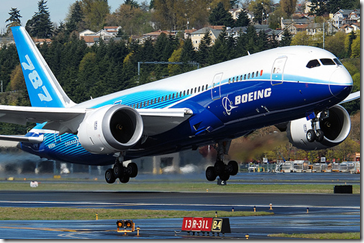 It will all work out. Given the space and time, the Boeing 787 Dreamliner will be our favorite plane.
It will all work out. Given the space and time, the Boeing 787 Dreamliner will be our favorite plane.
Surely, the grounding of the 787 Dreamliner was inevitable, and probably welcome by Boeing – it gives them the time they have earned over the past 10 years of development to generate solutions.
Like anything that ships, moving from beta systems to customer products increases the pressure and examination of systems by multiple orders of magnitude – beyond any level possible in the lab or test environment.
787 Dreamliner Competitive Advantage
Where are we, and where do we want to go with the competitive lead in fuel efficient air travel in the coming 25 years? Consider the hyped fear in industry under increasing microscope-level government regulators with itchy trigger fingers ready to fire at any sign of risk.
No one wants to be interrogated at those senate and house hearings we see on C-Span. That theater alone will stop (has already stopped?) innovation in many global industries that operate under US regulations.
This paralyzes the economy and can be traced not to engineering or manufacturing issues, but is brought on by panels that lack engineering competency or industry context to innovate sourcing and manufacturing at the 787 Dreamliner scale.
Competitive Advantage At Risk
One misstep and Boeing’s competitive advantage could go away without notice. Boeing’s insightful decision to focus on fuel economy over size and supersonic speed was and still is a well-aligned decision for the industry, airports, customers and the economy.
Misguided over-attention and uncompromising scrutiny is just what a competitor needs to steal all the knowledge and innovation gained at the expense of Boeing’s engineering effort, trial and testing. With not so much as a sound, Embraer, or Airbus (Boeing’s competitors) could take everything learned in the past decade and accelerate it, with fixes, into their product line. Boeing’s competitive advantage would be gone, in a snap.
Boeing would be held hostage by regulators, lawyers, and hearings as they defended the 787 Dreamliner. Boeing could be completely absorbed by this effort, reducing available minds focused on solving issues and potential speed of innovation we saw in the lifecycles of every Boeing aircraft to date.
Denver Airport Revisited
 Remember the Denver Airport? The advances in baggage handling systems there were disruptive. And, like the Boeing 787, there were glitches. Like any dramatic and quantum leap like the 787 Dreamliner, the Denver Airport baggage handling system crashed and burned in its early days. Engineers steadfastly worked out the problems.
Remember the Denver Airport? The advances in baggage handling systems there were disruptive. And, like the Boeing 787, there were glitches. Like any dramatic and quantum leap like the 787 Dreamliner, the Denver Airport baggage handling system crashed and burned in its early days. Engineers steadfastly worked out the problems.
Press and analysts predicted epic failure. Customers wanted to go back to Stapleton. Every major airport project since Denver has deployed similar systems for improved baggage handling. The industry changed, baggage handling became more efficient, effective, and at reduced cost. And customers benefited.
Allow Engineering Advantage to Prevail, Economically
I’m not suggesting that grounding the 787 Dreamliner was not in order. We value the FAA for their diligence and overseeing our safety. But let’s not predict the end of something that is going to change air travel for the future in a profound way. Like the Denver Airport baggage handling system, let’s get out of Boeing’s way, let them address the issues. The rewards from this quantum leap and disruptive innovation for air travel will benefit all of us.
Observe that the current systems and technologies in Boeing’s 737, 757, and 747 are not the same as the original technology and systems of the first of those models off the line. This is the time of vulnerability for the American Airline industry, and it behooves us to get out of the way. Stay vigilant, but get out of the way.
How do the principles of innovation, launch, iteration and advancement affect competitive advantage in your industry? This concept of competitive advantage is not unique to the Airline industry, for sure.
Please leave a comment, and share your thoughts with other readers.
Image credits:
787 Dreamliner Main Image: Drewski2112 via photopin cc
787 Dreamliner Featured Image: AvgeekJoe via photopin cc
Denver Airport: Koocheekoo via photopin cc










[…] Grounded 787 Dreamliner was inevitable, perhaps welcome by Boeing. […]
Stay tuned! Boeing might make a good future case study for author Tim Harford (Adapt) – how success always starts with failure.
[…] Grounded 787 Dreamliner was inevitable, perhaps welcome by Boeing. Let them solve issues, to retain competitive advantage from disruptive innovationExcerpt:One misstep and Boeing’s competitive advantage could go away. ______________________ Misguided over-attention and uncompromising scrutiny is just what a competitor needs to steal…Boeing’s competitive advantage______________________ Boeing’s insightful decision to focus on fuel economy over size and supersonic speed was and still is a well-aligned decision for the industry, airports, customers and the economy.Misguided over-attention and uncompromising scrutiny is just what a competitor needs to steal all the knowledge and innovation gained at the expense of Boeing’s engineering effort, trial and testing. Boeing’s competitive advantage would be gone, in a snap.Boeing would be held hostage by regulators, lawyers, and hearings as they defended the 787 Dreamliner. Boeing could be completely absorbed….reducing available minds focused on solving issues and potential speed of innovation we saw in the lifecycles of every Boeing aircraft to date.Read more: https://steinvox.com/blog/2013/01/24/boeing-787-dreamliner-disruptive-innovation-and-competitive-advantage/#ixzz2J20GzGZK From Deb, completely absorbed? Fight back:Change, Innovators, Creativity and Community, Will it Blend? […]
Hello Andrew,
Another good piece.
What this article highlights is the potential risk of overseers stifling innovation and by extension the country’s growth. It is a fine line between enough oversight and too little. In recent years I would argue we’re well into the Too Much zone though.
Cheers,
JT…
What is surprising is how such a small yet critical part (battery) can ground a billion dollar project….not sure if there was a supplier integration with Boeing or a QA break-down. speaks to the many things that can go wrong and stakes are high in products like aviation. I’ll bet they figure it out however, downside is too great not too.
Agreed. And, the upside is equally profound, I believe for the industry, energy consumption in aviation, connecting more small hubs with efficient aircraft with payload, transportation in general…, The innovation here is like the model T, it is the transition to new materials, new technology, new aviation. Other air-frame makers are primarily scaling “traditional” design to be bigger or smaller. It’s a safer strategy in terms of getting it right with the first plane off the line, but with its own set of risks. We’ll list those another time.
Bottom line…are you long or short on Boeing?
Ahh, Derek. You have cut to the chase! I am Long on Boeing’s ability to engineer and innovate great products. I am a poor market predictor. 😉
Innovation without risk. How does that work?
I don’t know why I’m always surprised that politicians and nay-sayers will find away to focus on the relatively minor engineering issues and ignore the obvious innovation and paradigm-shift this plane represents. I would point out that a technological step like this involves many, many partners including competitors and the competitive advantage that Boeing has in being first to market is only temporary at best. While Boeing will inevitably have to deal with far more bad press than they deserve, there is a strategic opportunity for them to show how responsive, responsible, and forward thinking they are.
Agreed, Kell. Risk is everywhere, and a project that doesn’t take risks, is probably not worth doing. As I re-read your comment, I believe this is an opportunity to rely on another part of the Boeing organization. While Engineering builds great aircraft, marketing and in this case, Public Relations (specifically crisis response) has an opportunity to handle the press noise, freeing up others. However, our culture, and paralyzed policies will continue to pick this apart. That is an unfortunate statement of our time.